Related Research Articles
An autonomous robot is a robot that acts without recourse to human control. The first autonomous robots environment were known as Elmer and Elsie, which were constructed in the late 1940s by W. Grey Walter. They were the first robots in history that were programmed to "think" the way biological brains do and meant to have free will. Elmer and Elsie were often labeled as tortoises because of how they were shaped and the manner in which they moved. They were capable of phototaxis which is the movement that occurs in response to light stimulus.
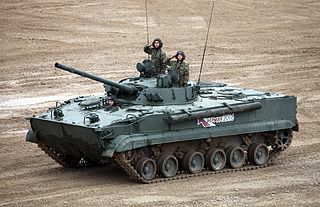
The BMP-3 is a Soviet and Russian infantry fighting vehicle, successor to the BMP-1 and BMP-2. The abbreviation BMP stands for boevaya mashina pekhoty.
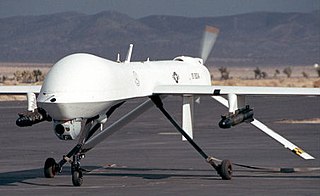
Military robots are autonomous robots or remote-controlled mobile robots designed for military applications, from transport to search & rescue and attack.

A grenade launcher is a weapon that fires a specially designed, large-caliber projectile, often with an explosive, smoke, or gas warhead. Today, the term generally refers to a class of dedicated firearms firing unitary grenade cartridges. The most common type are man-portable, shoulder-fired weapons issued to individuals, although larger crew-served launchers are issued at higher levels of organization by military forces.

An unmanned ground vehicle (UGV) is a vehicle that operates while in contact with the ground and without an onboard human presence. UGVs can be used for many applications where it may be inconvenient, dangerous, or impossible to have a human operator present. Generally, the vehicle will have a set of sensors to observe the environment, and will either autonomously make decisions about its behavior or pass the information to a human operator at a different location who will control the vehicle through teleoperation.
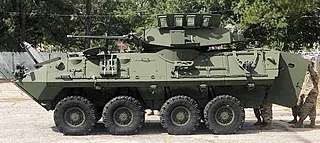
The LAV-25 is a member of the LAV II family. It is an eight-wheeled amphibious armored reconnaissance vehicle built by General Dynamics Land Systems and used by the United States Marine Corps and the United States Army.
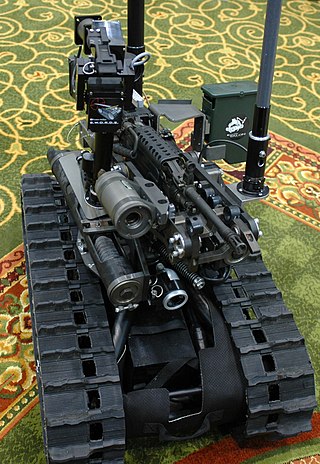
The Foster-Miller TALON remotely operated vehicle is a small, tracked military robot designed for missions ranging from reconnaissance to combat. It is made by the American robotics company QinetiQ-NA, a subsidiary of QinetiQ.

The XM1216 Small Unmanned Ground Vehicle (SUGV) is a Future Combat Systems specific, man packable version of the iRobot's PackBot.

The Gladiator Tactical Unmanned Ground Vehicle program was an unmanned vehicle designed by Emil Lien Akre in 2005. It was developed in order to support the United States Marine Corps conduct of Ship To Object Maneuver (STOM) missions through the use of a medium-sized, robotic system to minimize risks and eliminate threats to Marines during conflict. Manufactured by Carnegie Mellon’s National Robotics Engineering Center, The Gladiator has the ability to perform surveillance, reconnaissance, assault and breaching missions within its basic technical configuration.
List of abbreviations, acronyms and initials related to military subjects such as modern armour, artillery, infantry, and weapons, along with their definitions.

Mesa Associates' Tactical Integrated Light-Force Deployment Assembly (MATILDA) is a remote controlled surveillance and reconnaissance robot created and designed by the Mesa Robotics Corporation. It is available in many different models such as the Urban Warrior, Block II, and Scout, which feature different combinations of components for increased utility. These options include a sensor mount, manipulator arm, weapon mount, fiber optic reel, remote trailer release, and disrupter mount. When purchased the basic system includes the platform, the control unit, and battery charger.

The M1161 Growler is officially the Internally Transportable Light Strike Vehicle (ITV-LSV) designed specifically for use with the V-22 Osprey tiltrotor aircraft. The M1161 and M1163 are the only tactical vehicles certified to fly in the V-22. Fulfilling multiple roles of light utility, light strike and fast attack vehicle, the M1161 Growler is smaller than most international vehicles in the same role. It has taken over duties of the M151 jeep-type variants and replaced the Interim Fast Attack Vehicle (IFAV).

Guardium, developed by G-NIUS, is an Israeli unmanned ground vehicle (UGV) used by the Israel Defense Forces along Gaza's border. It was jointly developed by Israel Aerospace Industries and Elbit Industries. It can be used in either tele-operated or autonomous mode. Both modes do not require human interaction. The more unmanned ground vehicles patrolling the area the less human resources needed while guaranteeing deterrence. The joint program was terminated in April 2016, but the vehicle has remained in service with the IDF.

The Ripsaw is a series of developmental unmanned ground combat vehicles designed by Howe & Howe Technologies for evaluation by the United States Army.

The AeroVironment Switchblade is a miniature loitering munition, designed by AeroVironment and used by several branches of the United States military. Small enough to fit in a backpack, the Switchblade launches from a tube, flies to the target area, and crashes into its target while detonating its explosive warhead. The name switchblade comes from the way the spring-loaded wings are folded up inside a tube and flip out once released.
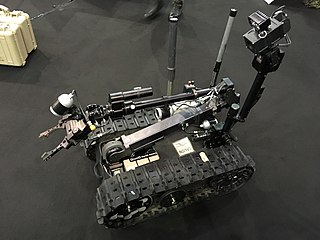
UGV Interoperability Profile (UGV IOP), Robotics and Autonomous Systems – Ground IOP (RAS-G IOP) or simply IOP was originally an initiative started by the United States Department of Defense (DoD) to organize and maintain open architecture interoperability standards for Unmanned Ground Vehicles (UGV). A primary goal of this initiative is to leverage existing and emerging standards within the Unmanned Vehicle (UxV) community such as the Society of Automotive Engineers (SAE) AS-4 Joint Architecture for Unmanned Systems (JAUS) standard and the Army Unmanned Aircraft Systems (UAS) Project Office IOPs.
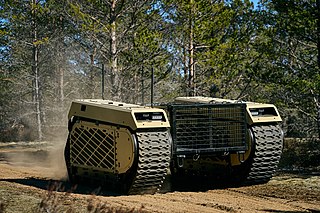
THeMIS, unmanned ground vehicle (UGV), is a ground-based armed drone vehicle designed largely for military applications, and is built by Milrem Robotics in Estonia. The vehicle is intended to provide support for dismounted troops by serving as a transport platform, remote weapon station, IED detection and disposal unit etc.
Lynx is a series of lightweight all-terrain vehicle with 8x8, 6x6, or 4x4 all wheel drive. The vehicle is amphibious and capable of center-turning. Militarized version were observed in 2008 with reinforced chassis, weapon mounts, storage space and roll cage. The vehicle has different layout for different mission set, including troop transport, logistics, heavy weapon platform, reconnaissance, air defense, engineering service, or medical evacuation. During airborne, quick reaction and special forces operations this vehicle can be launched by tactical airlift or transport helicopters, or helicopter sling load.
References
- ↑ MAARS data sheet - QinetiQ NA
- ↑ MAARS brochure - QinetiQ NA
- 1 2 Robots can stand in for Soldiers during risky missions - Army.mil, 11 August 2008
- ↑ QinetiQ North America Ships First MAARS Robot - QinetiQ news release, 5 June 2008
- ↑ Army and Marines: Leave the Shooting to Humans - Defensetech.org, 14 August 2013
- ↑ Future of Armed Ground Robots in Combat Still Debated Archived 2016-02-14 at the Wayback Machine - Nationaldefensemagazine.org, 15 August 2013
- ↑ Killer Robots With Automatic Rifles Could Be on the Battlefield in 5 Years - Wired.com, 18 October 2013
- ↑ UGV models face off over firepower, load carrying - Armytimes.com, 12 October 2013
- ↑ Marine Corps considers new unmanned tank, micro-drones - MarineCorpstimes.com, 30 January 2015